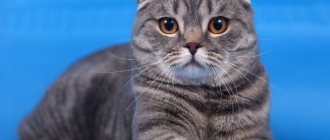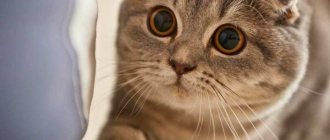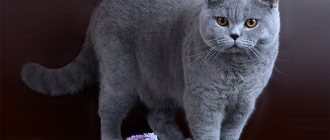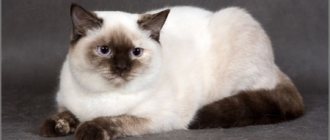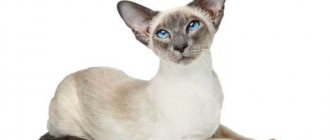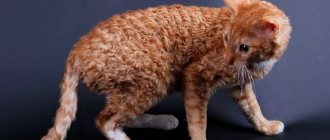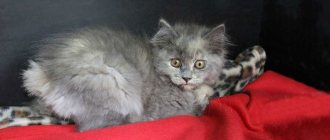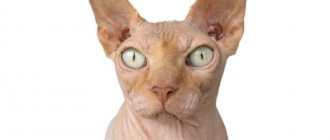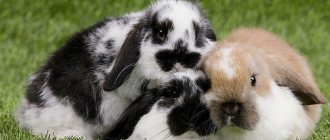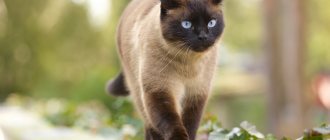Home » Cat Breeds
When we mention the British cat breed, most of us immediately associate with a large, well-fed cat with a smile and a plush gray fur coat. But the British have a lot of colors. One of the most interesting and popular among cat lovers and professional breeders is the blue point color.
- 2 Brief history of breeding cat colors
- 3 History of the appearance of the British Blue Point color
- 4 Blue point color standards
4.1 Table: EMS encodings according to WCF and FIFe standards
- 4.2 Video: bluepoint cat
- 5.1 Video: cats and genes
What does the Blue Point color mean?
An unusual coloring called Color Point has long been characteristic only of the Siamese breed. Its main difference is the presence of color only in certain places, the so-called points.
The shade appears only on the tail, ears, paws and nose, the rest of the cat’s body remains white.
At birth, babies are completely white, and only then the tail gradually darkens, then the ears, and lastly the paws become colored and a mask appears on the face.
Variations
In addition to the classic blue point, today there are several more variants of this shade:
- In Blue Tabby Point , the markings on the paws and face are not uniform, but striped (tabby). On the forehead the stripes form the letter M.
- The Blue Ticked Point is a recent development and is very rare. It originated from Abyssinian cats and is distinguished by the fact that a ripple effect is visually created on the body, making the fur look like the skin of a rabbit or chinchilla.
- In the Blue Cream Point , blue-gray markings are evenly mixed with cream. The nose can be either dark or pink.
- The blue tortie point has a tri-color tortoiseshell pattern. This is a chameleon color that changes its appearance throughout its life. Each cat of this shade is unique due to the arrangement of bluish-cream markings.
Blue cake point
Caring for a cat with point colors
Experienced breeders recommend paying special attention to cats with this color. The optimal air temperature is 25-28 degrees. When it sharply decreases, the fur will darken; when it increases, the marks will become lighter.
Long-haired cats need to be brushed daily. If matted hair has to be cut, darker hair will grow in its place.
Blue point cats, which appeared not so long ago, quickly won the love of breeders for their unusually beautiful colors. Those wishing to purchase a kitten of this noble shade have a choice of breeds and variations.
Caring for a Blue Point pet is not much more difficult than caring for any other cat.
If you decide to buy a baby with blue markings, I wish you good luck in raising him and joy in your future life with him.
The Thai cat is characterized by a unique and rare appearance. The “blue point” color, which means “blue dot,” is very popular among breeders.
Animals with this color have light fur and a slightly darkened muzzle, tail and limbs. Because of this color, it seems that they are wearing “dark socks” on their paws. Because of such unusual colors, many people want to get this breed of cat.
Thai cat: breed description, standards
Thai cats have a good character. They are unusually smart, easy to train, clean and quite sociable. Like any creature, they have not only good qualities, but also bad ones. If they are treated with respect, they will behave well.
As for appearance, there is a standard:
- The standard is considered to be medium-sized animals, weighing from 5 to 8 kg. They should have a compact, muscular body with a broad chest and be gracefully built.
- In accordance with the World Cat Federation (WCF) standard, the animal's head should be rounded with an extended forward muzzle, similar in appearance to a wedge. The chin should not protrude forward. The norm is round cheeks, not too plump.
- The cat should have a short neck, not a long one.
- The eyes are large, almond or lemon shaped, blue to blue in color.
- The ears are wide and length is medium. The tips of the ears are slightly rounded.
- Legs are strong, with developed muscle mass. The length is average, corresponding to the size of the body. The size of the paws is small and round.
- The length of the tail is commensurate with the proportions of the body.
- The coat is short, thin, without undercoat. It should be slightly adjacent to the skin and feel smooth to the touch. The standard coat color is acromelanic.
The colors of the “Thais” are varied, as are their shades. They can be plain, striped or spotted. One of the main features of the color is a dark “mask” located on the muzzle. Individuals with a bright contrast of points enjoy great success at the exhibition.
Types of tabby
Tabby (or tabby) coloring suggests the presence of a zonal pattern. This could be the letter “M” on the forehead, eyeliner on the nose and eyes, a necklace on the chest, rings around the ponytail and paws, highlighted spots on the back of the ear and curling patterns on the cheeks. The standards dictate that all stripes should have a small width, and in merle colors there should be a smooth, gradual transition into spots, which then form patterns on the cat’s belly and neck. The pattern is often very bright and stands out well against the base background, often contrasting with him. The tip of the nose and eyes appear slightly circled.
Tabby color types are divided according to the following principles.
According to pattern type
- Tiger (aka mackerel) - has vertical, narrow, distinct stripes on the sides. On the neck the pattern forms something like a wide collar, the tail is striped. The stripes on the sides rise higher and on the back form a pattern that is somewhat reminiscent of a saddle.
- Spotted refers to the presence of spots of various shapes and sizes, but the contours of such spots are usually very clearly defined. Along the spine, the spots may create a line that runs from the head to the base of the tail, which is also covered in stripes. There are also spots on the stomach, but much smaller in size.
- Marbled (shaded, whiskas) - a pattern of spots and stripes scattered randomly throughout the coat. Representatives of this variety can have almost any color, but the distinct pattern will always provide a bright visible contrast with the base shade. This breed got its name because its coloring is a bit like the patterns on well-polished marble.
According to color
- Silver. The main background is silver, the patterns are black.
- Silver blue. With snow-white undercoat, sides, face and tail.
- Red. Light red base with patterns of deep red tones.
- Brown. A shade of old, darkened copper with a black pattern.
- Blue. The base is cream or blue tones, the pattern is rich.
- Cream. The base is very light, creamy, the pattern is much darker, maybe beige.
- Tabby cameo. The base is snow-white with stripes of red tones.
Color of Thai cats
A distinctive feature of the Thai color is contrast. The best are considered to be those in which the dark color of the limbs and muzzle predominates over the light shade of the body.
The following colors are considered classic:
The Thai breed is expensive, but the fawn point color is especially valued. These are gray animals whose fur has a blue tint. And the caramel point color is individuals with light red fur and a white tint. These 2 species are rare.
Color of Thai seal point cats
The seal point color is common among Thai cats. The basic color of the coat of these animals varies from white to soft cream. The animal's paws and its muzzle stand out significantly against the general background with a dark color, which is 2-3 tones darker than the main one. There are also individuals of unusual colors, for example, dark brown and completely black.
Detailed description and color features of Blue Point cats
Blue Point is an unusual color that is a weak or diluted copy of the Seal Point color. It differs from other species in the appearance of color in certain places (points). So, in a completely white cat, the shade will appear on the paws, nose, ears and tail.
Features of the suit:
- Blue eyes;
- white fur covered with blue-gray spots;
- The paw pads and nose are dark slate in color.
Color requirement: all points on the coat must be clearly different from the main tone and be of the same shade. The mask-shaped mark on the muzzle should smoothly transition to the ears, without affecting the parietal part of the head.
Thai seal tabby point cats
Tabby or tabby color is a “new wave” in the development of Thais. Translated from English, this word means “striped.” American breeders gave this color the name Lynx Point. This includes several identical varieties of animals, which are distinguished only by the shades of their stripes. Shades can vary from cream to brown.
Color features:
- the points are well defined and the darker they are, the darker the animal’s nose and the skin of the paw pads;
- the “M” symbol is visible on the frontal part of the head;
- the eyes are outlined by a black or brown rim, which also runs around the nose;
- In places where the mustache grows, black dots are clearly visible.
The seal tabby point color is the classic and most common color. The fur of these animals is cream-colored with black stripes. If a cat has a red spot around its nose, this is considered normal.
Thai red point in cats
Red point animals can be of all shades from white to cream. The main color of the coat is decorated with orange or red points.
There are specimens with dark yellow and dark red shades. The nose and skin of the animals' paws are dark pink.
Point colors of the Scottish Straight cat
This color is often called “Siamese” by cat lovers. The main characteristic of the Point is that the legs, tail, ears and muzzle are darker than the main coat. The following variations are allowed:
- Blue point - as the name implies, there are blue marks in the areas indicated above. It is preferable that the blue is not very dark. The main coat is white.
- Cream point is a completely cream color. Only the main part of the fur coat is painted in a lighter shade, and individual parts are painted in a darker shade.
- Cream Blue Point is a rather interesting variation, in which the body is grayish-cream, and the muzzle, paws, ears and tail are dark gray.
- Lilac Point – there are purple markings on the snow coat.
- Chocleate Point is a very beautiful color, in which specks of a rich chocolate palette adorn the snowy coat.
- Chocolate Smoke Point – a whole scattering of chocolate! The main surface of the fur coat shimmers with a light variation of brown, and the remaining necessary areas are dark.
- Red point - the white cover is marked with red areas.
- Tortie point - in simple words, it is a tortoiseshell color mixed with cream or red spots.
- Tabby point - light coat marked with striped areas in the right places.
Whatever the point variant, the eyes should in any case be colored blue.
These cats are extremely careful and reasonable. Cleanliness is also their calling card.
Maintaining the color of a Thai cat during breeding
The Thai breed continues to improve and develop thanks to professional breeders. Animals acquire new colors and become more attractive. The Thai cat matures early. She becomes ready for mating by the age of one year.
To preserve the color of the breed, you must follow the following rules:
- Only by crossing purebred individuals can you get purebred kittens, so you cannot breed a Thai cat with other breeds. It is better to look for a partner in nurseries.
- It is recommended to select a partner based on color. Animals must be the same color.
If whitish spots or dark spots appear on the kittens' fur in the belly area, this will be considered a flaw in the exterior. All eye colors except blue are also considered a deviation.
Breeding and nurseries
The Scottish Straight cat breed is popular in many countries around the world, although straights are usually considered secondary in the Scottish breed, where all attention is focused on folds. For the same reason, straights are slightly cheaper than their fold-eared counterparts
In order to improve the breed, American Shorthair and British breeds are allowed to breed Scottish. The presence of impurities in kittens can be seen in the pedigree.
There are two directions of Scottish breeding - American and European. American breeders are ahead of their European colleagues in the quality of offspring obtained, including thanks to special breeding programs.
The Scottish Straight breed is very common all over the world, including in Russia. Scottish cat breeders can be found in almost any major city. Each of the nurseries has its own goals and objectives when conducting breeding work. When contacting a nursery, you need to understand what type of animals the nursery develops and what line is leading. Information about catteries and the breed can be obtained by visiting cat shows, or by contacting a club in your city.
Some nurseries:
Briefly about the British breed
The British cat breed is considered one of the most ancient; the first mentions of domesticated cats and their images, visually reminiscent of modern Britons, are found in handwritten books of the 7th-8th centuries. However, the breed was officially recognized only at the end of the last century.
British cats became especially popular in the 19th century
Cats of the British breed are distinguished by a large, massive and slightly squat physique . The average weight of males is usually about 7–8 kg, but sometimes individual individuals can reach 10 kg. Females are rarely heavier than 6 kg; they are considerably smaller and more graceful. The British have a muscular, stocky, harmoniously sculpted body with a wide sternum, a massive shoulder girdle and back, as well as strong, thick, slightly short legs. The forehead-shaped, round head with large eyes and wide-set ears is firmly set on a short but strongly developed neck. The chin is well defined, the nose is short and quite wide, and the whiskers are clearly visible on the voluminous cheeks. The tail is of medium length, proportional to the entire body of the animal, thick at the base, tapering towards a rounded tip.
Description
These animals have the following appearance features:
- weight about five kilograms for boys and three and a half for girls,
- rounded head shape,
- elongated graceful body,
- graceful plastic movements, mobility,
- forehead is convex, high, rounded,
- eyes wide apart, open, large, expressive,
- round muzzle, developed chin,
- Medium length and width of the paw, harmoniously combined with the body,
- the tail can be long and very long, tapering at the tip,
- The nose can be either medium or short. It is wide and with a recess,
- very soft, thick undercoat, hair does not fit tightly to the body,
- fur can be both short and long,
- The ears are small or medium-sized, rounded at the tips and wide at the base.
A Brief History of Breeding Cat Colors
Initially, all cats had variegated colors, which allowed the animals to remain unnoticed in the forest. Human intervention has made their color, by which we mean the color of the coat and various patterns on the skin (stains, all kinds of spots, stripes, etc.), extremely diverse. As a result of crossing individuals with certain characteristics, offspring of the desired color appeared. To consolidate the result obtained, only these animals were used in future breeding work; all others were excluded from the breeding process.
There are a lot of colors of cats bred
The history of the appearance of the British Blue Point color
Bluepoint color is one of the varieties of color point color, which appeared as a result of the deliberate introduction of Siamese and Thai cats into the British breed. The goal of the breeders was to obtain Britons with an uncharacteristic Siamese or Himalayan (as it is called in America) coloring.
Siamese and Thai cats were used to breed the blue point color from the British.
What to feed a Scottish kitten?
Scottish cats are very fluffy and cute, many people dream of having such a pet. Their skin comes in different colors, from marbled to point. Scottish Straights (straight-eared Scots) originated in Scotland, as can be understood from the name. Only recently has the breed gained independence, because there is also a fold-eared variety. Such a kitty will bring a lot of positivity and joy to any home. She will get along well with small children, will not bite or scratch them, will gladly take part in games and fun, and when she gets tired, she will simply hide in her house. By the way, she needs a house - it is important that the animal has a place where it can retire and be in peace and quiet, without communicating with anyone and gaining strength.
Blue point color standards
The main background of the coat of the British Bluepoint is as close as possible to pure white cold color or has a slight gray-bluish tint . The muzzle, paws, tail and ears are painted in contrasting blue.
All marks (points) are strictly in the same key and differ sharply from the main tone. The darkened mask on the face blends neatly and smoothly with the deep gray colored ears, without encroaching on the parietal area.
The muzzle, ears, paws and tail are painted gray.
The skin is normal light pink, and the nose and pads on the paws have a noble dark gray (slate) color. The iris of the eyes is exclusively blue and light blue.
The brighter and richer the color of a cat's eyes, the more noticeable the contrast with the fur. Such individuals are more valuable.
The eyes of the British Blue Point should be colored blue or light blue.
Table: EMS encodings according to WCF and FIFe standards
| Sign | Code | Name | |
| Breed | BRI | British | British |
| Coat color | a33 | blue point Colourpoint | Siamese color (even white with blue) |
| Iris color | 61 | blue eyes | blue or blue |
| Ears set | 71 | straight ears | straight, erect |
| Tail length | 54 | longie (more than 3 cm) | normal tail length |
There are several variations of the classic blue point, characterized by heterogeneity of markings (stripes on the paws and face). Such patterned colors are usually called links-point and are designated with the code 21 33.
Point cats may have uneven markings and are called linx-point cats.
The contrast of the blue point color is extremely important; the boundaries should be clearly visible.
Video: bluepoint cat
Anomalies and features inherent in the British Bluepoint
The term color point is translated as colored dots (marks). The color of a cat's fur and iris is determined by the presence of a special coloring pigment (melanin), which is synthesized under the influence of tyrosinase (a copper-containing enzyme) from the amino acid tyrosine. The production of the enzyme is supervised by the C (Color) gene. When this gene is mutated, which is now designated by the symbol c, tyrosinase is not produced and, as a result, the dark coloring substance (melanin pigment) is not produced. The animal turns out to be colorless and uncolored - an albino.
Albino cats are often deaf
The Siamese gene (cs) is formed in a similar way, when the main gene C is damaged. The only difference is that the enzyme that oxidizes the amino acid acquires thermosensitive properties. It is activated and produces melanin only at certain low temperatures; at higher temperatures it does not manifest itself at all. This phenomenon is scientifically called acromelanism.
Acromelanism is a genetically determined temperature-dependent type of pigmentation with full manifestation only on the limbs, ears, tail and muzzle and with lighter colored fur on the body. It is found in Siamese and Himalayan cats, rabbits, rats and other species of domesticated animals. It is a form of albinism.
This is how the Siamese thermal effect is obtained, when the peripheral remote (cold) areas of the body with a slightly lower temperature are colored. At the same time, the pigment is almost not synthesized in the remaining warmer areas of the animal’s body. The Blue Point cat is actually gray (blue), but its color appears only on the ears, face, tail and paws.
The Siamese color can appear in varying degrees of intensity.
Newborn kittens are light, almost white, because it is warm in the womb of the mother cat, the temperature is the same and melanin is not produced. The point coloration in babies does not develop immediately. First the tail darkens, then little by little the ears, and only then the nose and paws. The mask on the face is the last to darken; during the first two months of life, only one nose of the kitten may be colored. Points begin to appear literally a few hours after birth and are finally formed only by a year, or even later.
Pointed kittens are always born completely white.
It has been noted that all pointing cats are prone to general darkening with age, while maintaining an obvious contrast between body tone and marking color.
We live in a private house and by the color of our Siamese cat we can safely judge the current time of year. In the summer, when it is warm and she often walks outside, her fur becomes lighter and even the dark areas on her face, paws and tail become less bright. In winter, the pet gets very dark, because the floor is cold, and that is where she most often lives, although she tries to lead a sofa lifestyle.
The color-point phenomenon
As a result of a mutation in the gene (Color), which is responsible for color, different intensities of coloring of different parts of the body arise. The coloring is most intense on remote (and therefore colder) areas of the body, such as the muzzle, ears, paws and tail, and on the rest of the body surface, where the temperature is higher, practically no pigment is formed. It doesn't disappear completely, but it does lighten to almost white.
Accumulations of pigment in remote areas of a cat's body are called points, translated as a dot or mark. And the color of cats, with intensely colored points in relation to the main body, is called color point, or colored markings.
British Color Point Chocolate
The gene responsible for the Siamese color (cs) is recessive. In order for it to manifest itself, each of the parents must have it: either be color-pointed or be a carrier of this gene in their ancestors. In addition, this gene is linked to blue eye color.
Features of keeping and caring for the British Blue Point
The original heat-dependent point color imposes some restrictions on the living conditions of such cats. First of all, it is extremely important to maintain the optimal temperature in the room; it should be between 25–28 °C. When there is a sharp cold snap, the cat’s coat darkens; in extremely warm temperature conditions, the marks lighten and become almost invisible.
Some foods negatively affect the color of the coat, causing it to darken or yellow:
- seaweed and any seafood containing high amounts of iodine;
- carrots (raw and boiled);
- buckwheat grain;
- beef;
- liver and other foods rich in copper.
It is better to feed British Blue Point cats with special food for Siamese cats
You should be extremely careful when giving your color-point pet vitamin complexes and ready-made store-bought foods with kelp, as well as those enriched with microelements (I, Cu).
If a predisposition to color changes is noticed, then it is better to opt for specialized food for Siamese cats.
If possible, traumatic damage to the skin and operations should be avoided, since the hair on the damaged area of the skin grows much darker than on the rest of the body. The scarred tissue is colder, which provokes the synthesis of the coloring melanin. This is why pointing cats always have their nails trimmed in a timely manner (at least once every 2-3 weeks) and their ears cleaned (at least once a week). A restless, itchy cat may very well scratch itself. The appearance of scratches is extremely undesirable. Sometimes the color is restored after another moult, but this does not always happen.
Particular attention is paid to the care of the coat (applies to long-haired Britons), which must be thoroughly combed daily. The resulting tangles on a neglected animal will have to be cut off, and the newly grown coat will be darker.
If pointing cats are not kept correctly, their fur will darken.
After a sterilization operation, our Siamese cat developed two dark spots on her stomach, exactly where the incisions were. Moreover, light, almost snow-white areas appeared near them. Almost two years have passed and the color has not recovered.
The rest of the care is standard and consists of the following procedures:
- brushing your teeth (every 5–7 days);
- rubbing eyes (daily);
- bathing using special shampoos (1–2 times a year);
- vaccination (annually);
- prevention of parasites: against worms - suspensions, tablets, etc.;
- for fleas - collars, drops on the withers, shampoos, etc.
Diseases and treatment
The gene mutations that brought Folds from a Scottish farm into the big world created the preconditions for hereditary problems, including osteochondrodysplasia. This is a hereditary and often fatal joint disease in which the growth of a kitten's bones and cartilage is disrupted or deformed.
Among the common diseases of Scottish fold cats are the following.
- Ophthalmological. Entropion of the eyelid is a congenital pathology and can be corrected surgically. Glaucoma and cataracts (a disorder of the structure of the eye) can develop with age.
- Skin. Allergies and eczema - manifest as redness and itching. A cat can become infected with demodicosis and scabies, which are caused by parasites.
- Ear. Congenital complete or partial deafness. Of the acquired ones - infection, otitis media.
With age, many Scots develop problems with the cardiovascular and digestive systems, which can only be noticed and diagnosed by carefully observing the appearance and behavior of the pet. Straights are hardier and less susceptible to hereditary diseases.
Vaccinations are mandatory, even if your cat never leaves the apartment, since the source of infection can enter the house through clothes and shoes. Cats are vaccinated against rhinotracheitis, panleukopenia, calicivirus, chlamydia and rabies. The first vaccination is carried out at 2.5-3 months, a month later - revaccination and rabies vaccination. It is best to consult your veterinarian about schedule and vaccines.
Features of mating British blue point dogs
The bluepoint color is quite difficult to breed, since the cs gene is recessive (suppressed). Only when both producers (male and female) have such pigment colors, the kittens in the litter will be guaranteed to be pointing only. Parents with smooth, monochromatic hair who are carriers of the cs gene can also produce children with Siamese pigmentation, but with a 25% chance. If a Blue Point female or male is bred with a carrier of the gene, half of the kittens are born white and then acquire the characteristic blue markings.
The genetics of color point colors are very complex.
The color gene can quietly sleep for several generations and manifest itself only in grandchildren or great-grandchildren, delighting the breeder with an unexpected pointing kitten.
Once upon a time, my parents had a Siamese cat, Sima. She was extremely fertile and regularly gave birth to offspring of 5-6 kittens. The babies always turned out with Siamese colors, completely regardless of what their father was like. But they often had defects in coloring. Some kittens had white spots on their paws and tail, and this was immediately noticeable, since the process of darkening the fur began quickly.
Character
There is an opinion (not a proven fact) that the Blue Point Scotsman is a cat with character. The fact is that the blue colors of the Scots were originally obtained from British cats, known for their temper. Modern Scottish Blue Points are somewhat similar in character to the British: they are independent, willful, and can be aggressive if they don’t like something. However, the degree of expression of these qualities depends on the presence of British cats in the immediate family.
If there are a lot of British people in the document, you should expect a tougher character, and vice versa. However, British genes will still be softened by Scottish ones, so such cats are more sociable and kinder than their British counterparts.
The Scots are very careful with children, but do not like particularly intrusive tactile attention.
Peculiarities of participation of British Blue Point dogs in exhibitions
A British Blue Point that meets all standard breed requirements can freely participate in any cat show events. The cat must be healthy, vaccinated and have all the necessary documents (application for participation, veterinary record, pedigree, etc.).
Preparation for the exhibition consists of the following actions:
- if the fur looks sloppy and greasy, then bathe the cat using a specialized shampoo and conditioner;
- trim and file claws;
- wipe ears and eyes;
- brush your teeth with a brush and toothpaste that does not need to be washed off.
British blue pointers often win medals at cat shows
Individuals with the following defects are not allowed to participate:
- excess or insufficient number of toes;
- problems with the jaws (overbite or underbite over 2 mm);
- tail defects (thickening, creases, curvatures, etc.);
- with eyes that are not blue;
- if the paw pads or nose are not dark gray or have light spots on them;
- dark spots on the abdomen;
- defects in the coat (weak sparse undercoat, etc.).
